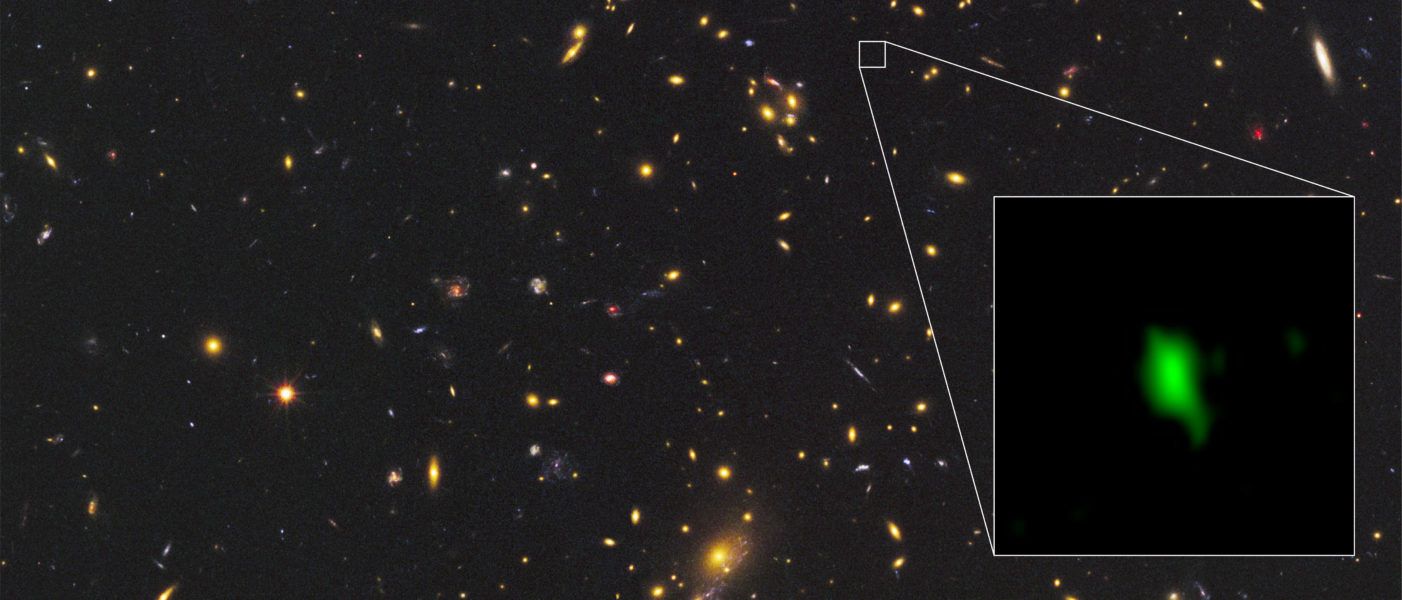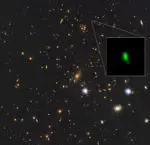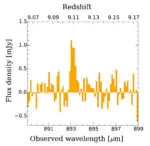ALMA Finds Most-Distant Oxygen in the Universe
15 May, 2018 / Read time: 7 minutes
Scientific Paper ALMA Kids PublicationAstronomers detected a faint but definite signal of oxygen in a galaxy located 13.28 billion light-years away from us, through observations using the Atacama Large Millimeter/submillimeter Array (ALMA). Breaking their records, this marks the most distant oxygen ever detected in the Universe. Referencing infrared observations, the team determined that star formation in the galaxy started at an unexpectedly early stage: 250 million years after the Big Bang.
“I was thrilled to see the signal of the most distant oxygen,” explains Takuya Hashimoto, the lead author of the research paper published in the journal Nature and a researcher at Osaka Sangyo University and the National Astronomical Observatory of Japan.“This detection pushes back the frontiers of the observable Universe.”
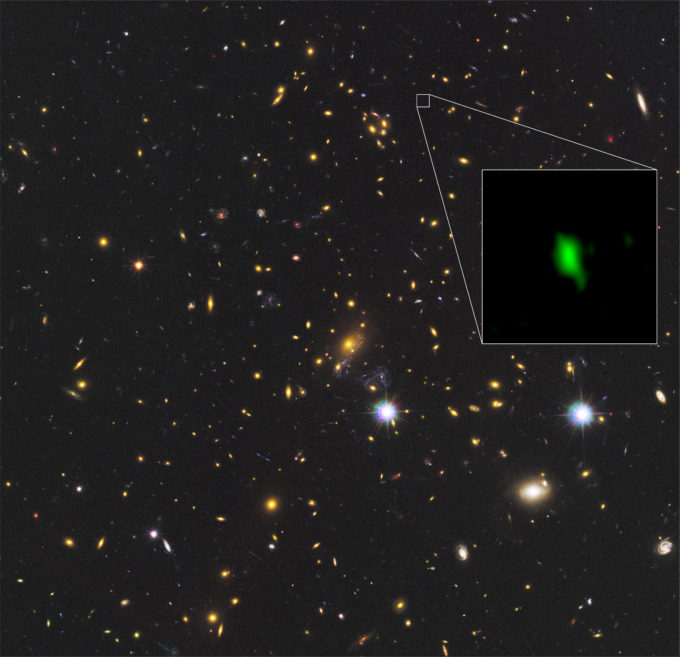
This image shows the galaxy cluster MACS J1149.5+2223 taken with the NASA/ESA Hubble Space Telescope and the inset image is the galaxy MACS1149-JD1 located 13.28 billion light-years away observed with ALMA. Here, the oxygen distribution detected with ALMA is depicted in green. Credit: ALMA (ESO/NAOJ/NRAO), NASA/ESA Hubble Space Telescope, W. Zheng (JHU), M. Postman (STScI), the CLASH Team, Hashimoto et al.
An international team of astronomers led by Hashimoto used ALMA to observe a distant galaxy called MACS1149-JD1. They detected a signal from ionized oxygen in the galaxy. The infrared light emitted from oxygen was stretched to microwave wavelengths by the expansion of the Universe before it reached Earth and was observed by ALMA. The team measured the change in the wavelength of the light and found that the signal had traveled 13.28 billion light-years [1] to reach us, making it the most distant, or oldest, oxygen ever detected by any telescope. Besides, a weaker signal of neutral hydrogen emissions was independently found with the European Southern Observatory’s Very Large Telescope; the distance determined from this observation is consistent with the range based on the oxygen observation. MACS1149-JD1 is the most distant galaxy with a precise distance measurement [2].
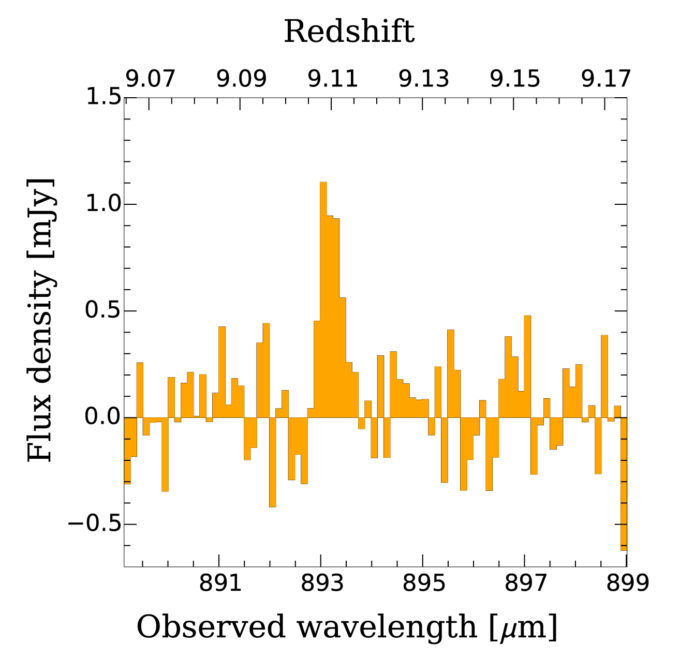
Microwave spectrum of oxygen ions in MACS1149-JD1 detected with ALMA. It was originally infrared light with a wavelength of 88 micrometers, and ALMA detected it as microwaves with an increased wavelength of 893 micrometers due to the expansion of the Universe. Credit: Hashimoto et al. - ALMA (ESO/NAOJ/NRAO)
For a period after the Big Bang, there was no oxygen in the Universe. Oxygen was created in stars and then released when the stars died. The detection of oxygen in MACS1149-JD1 indicates that an earlier generation of stars had been already formed and expelled processed oxygen by the age of the galaxy, which is only about 500 million years after the beginning of the Universe.
The team then reconstructed the star formation history in the galaxy using infrared data taken with the NASA/ESA Hubble Space Telescope and NASA Spitzer Space Telescope. The observed brightness of the galaxy is well explained by a model where the onset of star formation was another 250 million years ago. The model indicates that the star formation became inactive once after the first ignition, and then revived at the epoch of the ALMA observations; 500 million years after the Big Bang. The astronomers suppose that the first star-formation burst blew the gas away from the galaxy, which would suppress the star formation. Then, the gas returned to the galaxy leading to the second burst of star formation. The massive newborn stars in the second burst ionize oxygen, and it’s those emissions that have been detected with ALMA.
“The mature stellar population in MACS1149-JD1 implies that stars were forming back to even earlier times, beyond what we can currently see with our telescopes. This has fascinating implications for finding `cosmic dawn’ when the first galaxies emerged” adds Nicolas Laporte, a researcher at University College London / Université de Toulouse and a member of the research team.
ALMA has set the record for the most distant oxygen several times. In 2016, Akio Inoue at Osaka Sangyo University and his colleagues found the signal of oxygen at 13.1 billion light-years away with ALMA. Several months later, Nicolas Laporte and his team used ALMA to detect oxygen at 13.2 billion light-years away. Now, the two teams merged into one and achieved this new record. “This reflects both; the competitive and the collaborative nature of the forefront of scientific research,” said Inoue.
Richard Ellis, a senior astronomer at University College London (UCL) and co-author of the paper, concludes: “Determining when cosmic dawn occurred is akin to the Holy Grail of cosmology and galaxy formation. With these new observations of MACS1149-JD1, we are getting closer to directly witnessing the birth of starlight! Since we are all made of processed stellar material, this is really finding our own origins.”
Notes
[1] The measured redshift of galaxy MACS1149-JD1 is z=9.11. A calculation based on the latest cosmological parameters measured with Planck (H0=67.3 km/s/Mpc, Ωm=0.315, Λ=0.685: Planck 2013 Results) yields the distance of 13.28 billion light-years. Please refer to “Expressing the distance to remote objects” for the details.
[2] The galaxy GN-z11 is thought to be located 13.4 billion light-years away based on observations with the Hubble Space Telescope (HST). But the precision of the distance measurement with HST low-resolution spectroscopy is significantly lower than that of ALMA’s measurement using a single emission line from atoms.
Additional Information
These observation results are published as Hashimoto et al. “The onset of star formation 250 million years after the Big Bang” in Nature on May 16, 2018.
The research team members are Takuya Hashimoto (Osaka Sangyo University/National Astronomical Observatory of Japan), Nicolas Laporte (University College London/Université de Toulouse), Ken Mawatari (Osaka Sangyo University/The University of Tokyo), Richard S. Ellis (University College London), Akio. K. Inoue (Osaka Sangyo University), Erik Zackrisson (Uppsala University), Guido Roberts-Borsani (University College London), Wei Zheng (Johns Hopkins University), Yoichi Tamura (Nagoya University), Franz E. Bauer (Pontificia Universidad Católica de Chile/Millennium Institute of Astrophysics/Space Science Institute), Thomas Fletcher (University College London), Yuichi Harikane (The University of Tokyo), Bunyo Hatsukade (The University of Tokyo), Natsuki H. Hayatsu (The University of Tokyo/European Southern Observatory), Yuichi Matsuda (National Astronomical Observatory of Japan/SOKENDAI), Hiroshi Matsuo (National Astronomical Observatory of Japan/SOKENDAI), Takashi Okamoto (Hokkaido University), Masami Ouchi (The University of Tokyo), Roser Pelló (Université de Toulouse), Claes-Erik Rydberg (Universität Heidelberg), Ikkoh Shimizu (Osaka University), Yoshiaki Taniguchi (The Open University of Japan), Hideki Umehata (The Open University of Japan/The University of Tokyo/RIKEN), Naoki Yoshida (The University of Tokyo)
The Atacama Large Millimeter/submillimeter Array (ALMA), an international astronomy facility, is a partnership of the European Organisation for Astronomical Research in the Southern Hemisphere (ESO), the U.S. National Science Foundation (NSF) and the National Institutes of Natural Sciences (NINS) of Japan in cooperation with the Republic of Chile. ALMA is funded by ESO on behalf of its Member States, by NSF in cooperation with the National Research Council of Canada (NRC) and the Ministry of Science and Technology (MOST) in Taiwan and by NINS in cooperation with the Academia Sinica (AS) in Taiwan and the Korea Astronomy and Space Science Institute (KASI).
ALMA construction and operations are led by ESO on behalf of its Member States; by the National Radio Astronomy Observatory (NRAO), managed by Associated Universities, Inc. (AUI), on behalf of North America; and by the National Astronomical Observatory of Japan (NAOJ) on behalf of East Asia. The Joint ALMA Observatory (JAO) provides the unified leadership and management of the construction, commissioning and operation of ALMA.
Contacts
-
Nicolás Lira
Education and Public Outreach Coordinator
Joint ALMA Observatory, Santiago - Chile
Phone: +56 2 2467 6519
Cel: +56 9 9445 7726
Email: [email protected]
-
Masaaki Hiramatsu
Education and Public Outreach Officer, NAOJ Chile
Observatory, Tokyo - Japan
Phone: +81 422 34 3630
Email: [email protected]
-
Richard Hook
Public Information Officer, ESO
Garching bei München, Germany
Phone: +49 89 3200 6655
Cel: +49 151 1537 3591
Email: [email protected]
-
Charles E. Blue
Public Information Officer
National Radio Astronomy Observatory Charlottesville, Virginia - USA
Phone: +1 434 296 0314
Cel: +1 202 236 6324
Email: [email protected]
